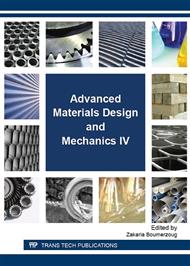[1]
Luru Chen. Current situation and development of steel pipe in structure. In: Proc of conf. on advances in steel structures. 2008. 10. 355-363.
Google Scholar
[2]
CEN: ENV1993-1-1, Euro code 3: Design of Steel Structures: Part 1. 1 General rules and rules for buildings. (1992).
Google Scholar
[3]
JGJ 82-91 Code of design, construction high strength bolting steel structure . Beijing: China Architecture & Building Press, (1993).
Google Scholar
[4]
AISC. Load and resistance factor design specification for structural steel buildings Chicago, IL American Institute of Steel Construction(AISC), (1999).
Google Scholar
[5]
Lanxi Wen. Tube analysis and Experimental Research on the full-scale bearing capacity of the ultimate strength of gusset plate connections. Hunan: Hunan University. (2006).
Google Scholar
[6]
G. Kiymaz, E. seckin. Strength and design of slotted and gusset plate welded tubular member connections in stainless steel. Journal of Constructional Steel Research 63, 293-304.
DOI: 10.1201/b13139-54
Google Scholar
[7]
Architectural Institute of Japan. Recommendations for the design and fabrication of tubular structures in steel[S]. Tokyo: Maruzen Co., ltd, (1990).
Google Scholar
[8]
Yu Luan, Zhen-Qun Guan, Geng-Dong Cheng, Song Liu. A simplified nonlinear dynamic model for the analysis of pipe structures with bolted flange joints. Journal of Sound and Vibration, 2012: 331 : 325-344.
DOI: 10.1016/j.jsv.2011.09.002
Google Scholar
[9]
Y.Q. Wang, L. Zong, Y.J. Shi. Bending behavior and design model of bolted flange-plate connection. Journal of Constructional Steel Research, 2013, 84: 1-16.
DOI: 10.1016/j.jcsr.2013.01.012
Google Scholar
[10]
Hoang Van-Long, Jaspart Jean-Pierre, Demonceau Jean-Francois. Behavior of bolted flange joints in tubular structures under monotonic, repeated and fatigue loadings I: Experimental tests. Journal of Constructional Steel Research. 2013, 85: 1-11.
DOI: 10.1016/j.jcsr.2013.02.011
Google Scholar
[11]
J. Shield, J. Wightman, Subsea Riser Products, J. Pappas, RPSEA, J. Bowman, Chevron. Fatigue Testing of Shrink-Fit Couplings for Joining High Strength Steel Riser Pipe. 2013 Offshore Technology Conference, 2013: 06 - 09, 2013, Houston, TX, USA, ISBN 978-1-61399-241-8.
DOI: 10.4043/24069-ms
Google Scholar
[12]
Luojun Zhu, Shenghong Wang, et al. Theoretical analysis on the the inner set bolted joint of steel tube. Journal of the Zhejiang Construction. 2012, (08): 28-30.
Google Scholar
[13]
Chao Huang, Li Xing. Experimental study of the Inner Bolted Joint of Steel Tube Subject to Axial Forces. Journal of Industrial Construction. 2015, 45(9):149-153.
Google Scholar


